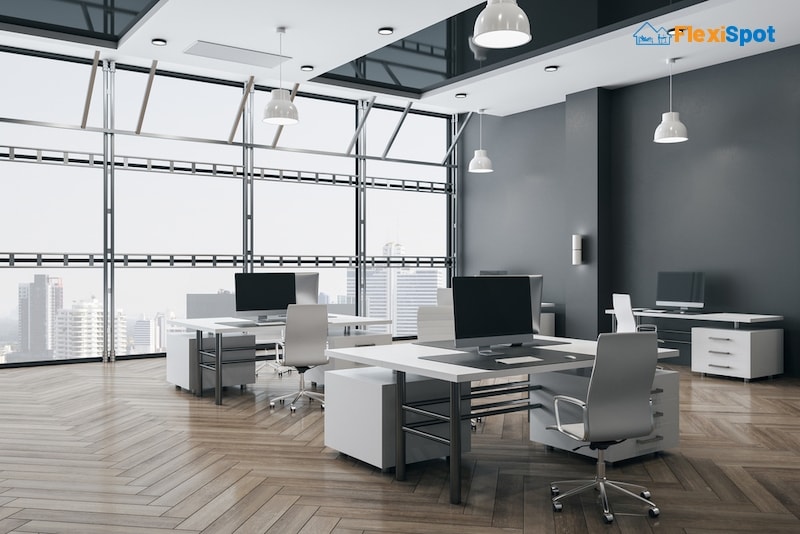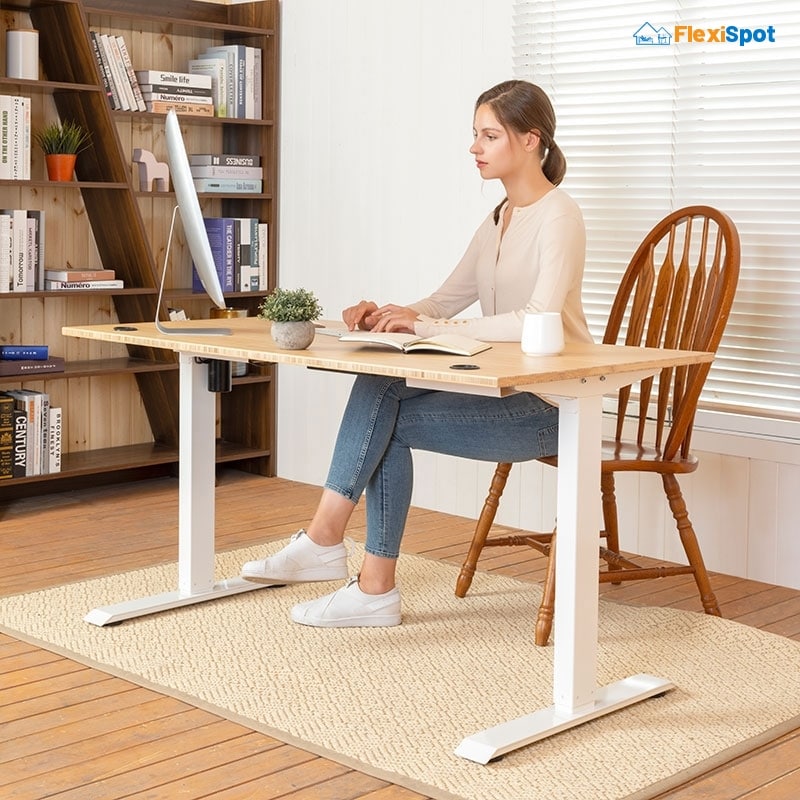An increasing number of employers are seen working on workplace ergonomics and shifting their focus from the business to their employee's well-being. It took a while for the concept of workplace ergonomics to become familiar and be accepted by the masses.
It's only now that the employers have understood that the only way to sustain in the market is to change their approach and work towards becoming more employee-oriented. The happier the employees are, the better they'll perform, and eventually, the more benefit the employers will be able to get!
Any efforts that an employer makes to make an employee feel good about their job will eventually come back to benefit them.
Today, two things that we see employers actively working on are workplace ergonomics and sustainability. However, little you may know that these two are quite closely related. Improving the ergonomics of a workplace automatically makes an organization more sustainable.
Sustainable organizations can be defined as those that are built to survive through the challenges, improve continuously to match the ever-changing market trends, and thrive as successful businesses in the future. Ergonomics is one of the most underestimated players in corporate sustainability.
According to the pioneer of corporate sustainability, W. Edwards Deming, about 85% of why a business fails can be attributed to the deficiencies in the process and systems and not the employees. The management should work on improving their processes rather than holding employees accountable for failures.
If you're interested to know more about how workplace ergonomics can help a business sustain itself and what the requirements for sustainable ergonomics in a workplace are, this blog post will help you understand everything there is!
Environmental Ergonomics in an Office Workplace
Workplace ergonomics focuses on providing employees with a safe and comfortable work environment. It focuses on designing the workplace and processes such that the tools and equipment the employees use and everything else they interact with at work don't put their well-being at risk. This is where the concept of environmental ergonomics in an office workplace comes into the picture.
Environmental ergonomics go far beyond the physical layout of the employees' workstations. It also encompasses the environment where an employee is working throughout the day. The principles that environmental ergonomics is based on are the office's climate, the lighting, and the noise. Let's look at how these can affect the employees' well-being and productivity and how you can implement them in your workplace design.
Climate
It's a given that anyone would be able to work better if the climate in their workplace is comfortable. You may not realize it, but the climate of your workplace can make you feel good about your job and enhance your productivity, or it can do the opposite.
When we say the climate of an office, we mainly mean the temperature, humidity, and air movement. Too much or too little of these factors can directly impact your productivity and mood. Imagine working in an office that either feels too hot or too cold, or too humid or where there's poor ventilation. Sounds suffocating, doesn't it? That's exactly where we're getting at!
Ideally, the temperature inside your office should be between 20 to 24 degrees Celsius. Always remember that the temperature inside your office shouldn't be too contrastive with the outdoor temperature. The humidity should be maintained between 40 to 60%. Depending on the outdoor weather, you may need a humidifier or dehumidifier. As for the air movement, maintain the drafts well below 0.2m/s, providing the same feeling as a light breeze.
Once you've got the ideal climate inside your office, your employees will feel great at work, their mood will be better, and they'll work with higher concentration and deliver better results.
Lighting
Office lighting is a small but extremely important factor impacting employee productivity. If the office lights are too bright or too low, they'll strain the employees' eyes excessively. The level of lighting is important, but the position of the lights is also important. Installing lights just behind a computer user would mean it'll reflect on the computer screen and affect the visibility of the worker.
If the lights are installed right in front of the workers, they'll shine right into their eyes and cause eye strain. Workstations shouldn't be arranged in a way that it has windows in the front or at the back of a computer user. The windows should always be on the left or right side.
The ideal level of office lighting is within the range of 45 to 65 foot-candles (500 to 600 lux). Lighting in this range will ensure that the lighting isn't too bright or dim, ensuring that the employees are comfortable and aren't exposed to eye strain due to poor lighting.
Noise
Well, do we need to exaggerate what difference noise can make in your work? If your office is too loud, you simply can't focus. This is why noise is an important principle of environmental ergonomics in an office. Usually, the volume of noise in a typical office is between 40 to 60dB.
It's usually the noise from typing, office fans, print and photocopy machines, and the chatter of people in the office. If the noise is too high, it'll affect employee alertness and result in annoyance, affecting productivity.
It would be best if you tried to maintain the background noise within the range of 48 to 55 dB. If you keep background noise between 54 to 59 dB, it'll effectively mask the noise from people conversing and help employees working focus more.
Requirements for Sustainable Ergonomics in the Workplace
Once you've altered the office environment to ensure the employees don't have to deal with any sort of disturbances and distractions, you can then move on to the next step to designing a sustainable workplace, and that is, ensuring sustainable ergonomics in the workplace.
Let's walk you through the requirements of sustainable ergonomics in the workplace.
Clearly-Define Purpose and Goals
The first requirement of sustainable office ergonomics is to identify and be clear about your purpose and set clear goals. Ideally, the purpose should be to reduce any ergonomics-related workplace injuries.
While this should be the primary purpose, if you get your workplace ergonomics game strong, you can serve numerous purposes and reap various intangible benefits which will help you stand out in the market and assist you with continuous improvement.
Some common benefits of good workplace ergonomics include the reduced occurrence of workplace injuries and reduced discomfort and fatigue, higher productivity and efficiency, enhanced quality of work, and reduced absenteeism and turnover.
Sustainable Workplace Ergonomics Strategy
Once you're clear about your purpose and goals, the next requirement is to strategize how you'll improve workplace ergonomics. The goals should be realistic with doable timelines. SMART-A is a good way to design the ergonomic process strategy for your workplace.
Ergonomics Training
You can't expect your employees to start practicing ergonomics just like that. Every person working at your office needs to be trained regarding proper ergonomics. From the correct way to sit to the correct way of using ergonomic equipment, it's your responsibility to walk your employees through everything they need to know and learn.
Metrics and Continuous Improvement
You should be able to measure the results of everything you're putting your time and money into, including the impact of workplace ergonomics implementation. It's only then that you'll be able to tell if what you implemented is actually working or not. And this also opens doors to continuous improvement, which will help you sustain the ergonomics in the workplace.
Teamwork and Hold Individuals Accountable
Establish an environment of teamwork and hold each individual accountable. These are the two things that'll contribute to the success of your workplace ergonomic strategy and ensure sustainable workplace ergonomics.
Key Steps to Sustainable Ergonomics
With a clear understanding of what you require to ensure sustainable workplace ergonomics, we can now take you through the key steps to sustainable ergonomics.
Encourage Movement
Did you know that staying in the same posture for too long and not moving can negatively impact productivity? According to a study, you can enhance employee productivity by 46% by encouraging them to alternate between sitting and standing. A standing desk like the Kana Pro Bamboo Standing Desk or a sit-stand desk will ensure that the employees aren't sitting or standing for too long.
Invest in Products that are Easy to Use
Invest in ergonomic products that are easy to use. Ergonomic office chairs and standing desks, for example, should be easy to adjust. If they're too difficult to use, the employees might not use them at all.
Purchase High-Quality Ergonomic Chairs for all Employees
Invest in office chairs with adjustable height, seat width and depth, adjustable and flexible backrests, and adjustable armrests. These features will ensure that the office chairs are adjusted to suit every employee's physique and comfort preferences.
Install a Source of White Noise
To make sure the office isn't too noisy, install a source of white noise that'll help you mask the noise and help employees focus better.
Install the Right Lights in the Right Places
Ensure to install the right kind of lights (that aren't too bright or dim) and at the right spots. The lights shouldn't be directly behind or in front of the worker.
The better the workplace ergonomics are, the higher employee productivity and efficiency will be. But that's not it. Sustainable workplace ergonomics ensure that the employees' physical and mental well-being is well taken care of. It also puts forth a good brand image of your company. People see you as a considerate employer who takes their employees' health seriously, which will mean a better reputation for you!




